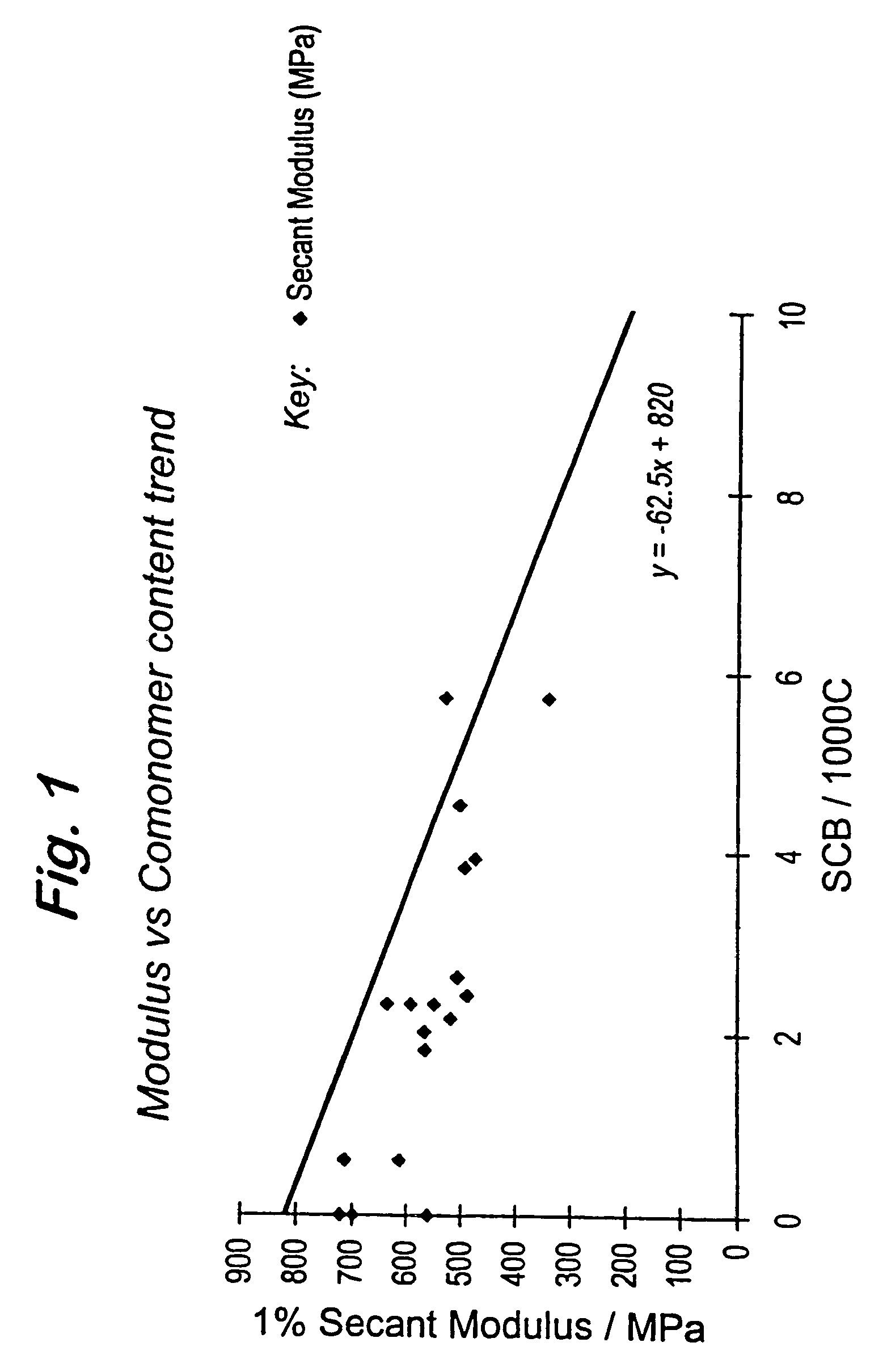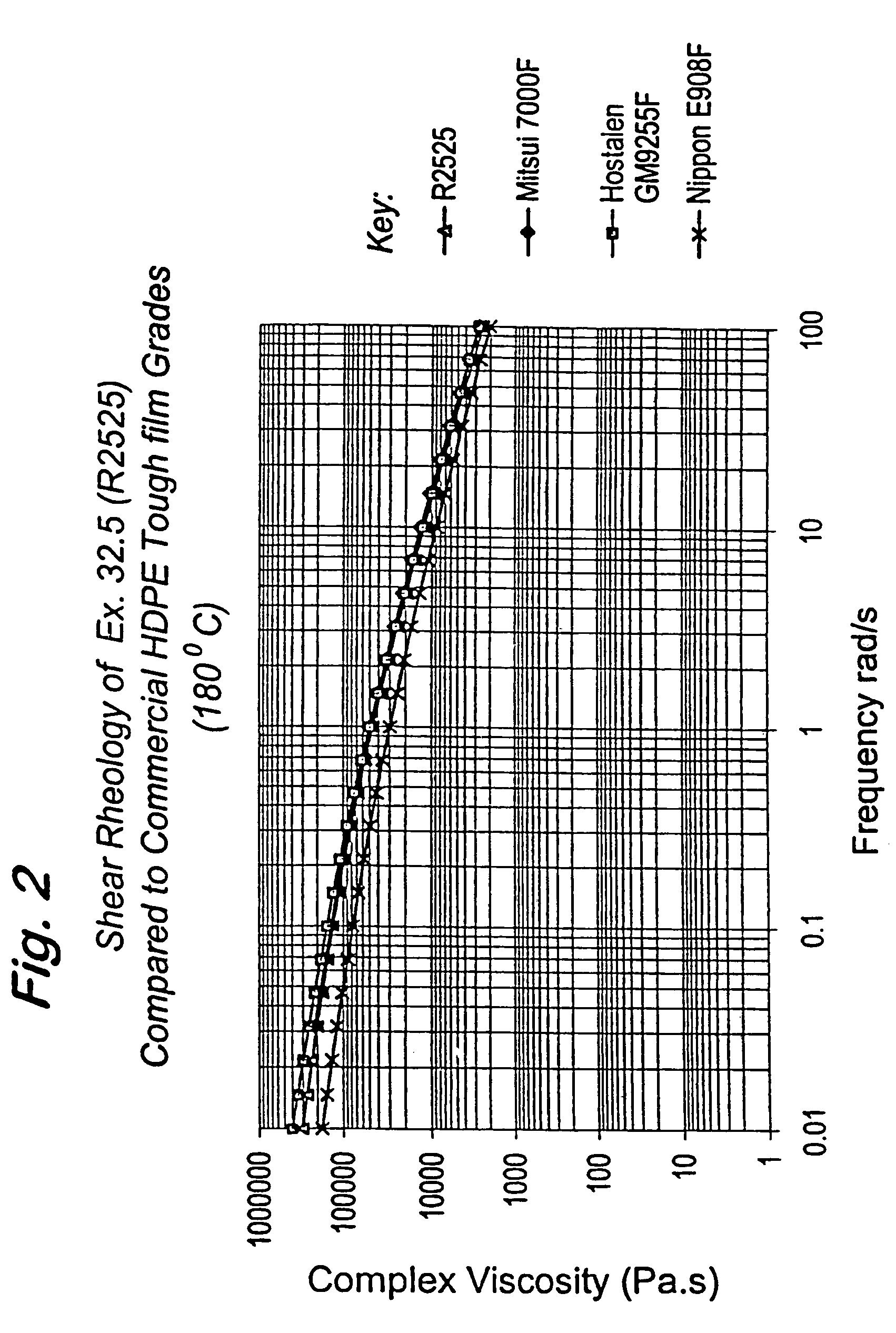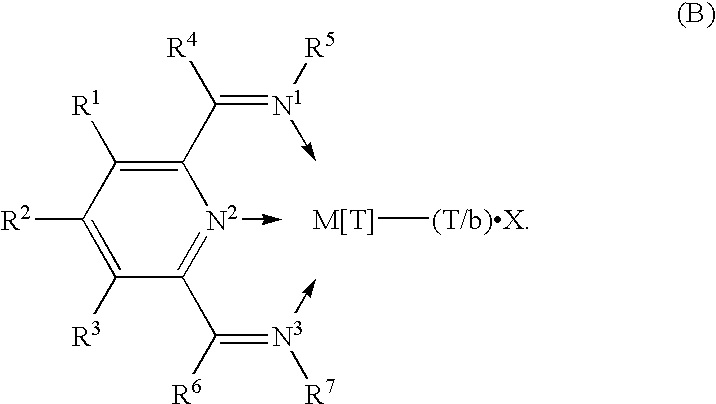Polymerization catalysts
a polymerization catalyst and catalyst technology, applied in catalyst activation/preparation, chemical/physical processes, iron organic compounds, etc., can solve the problems of high sensitivity, large quantity of expensive alumoxanes, and small residual catalysts in the produced polymer, so as to achieve high activity and improve performance. , the effect of processing
- Summary
- Abstract
- Description
- Claims
- Application Information
AI Technical Summary
Benefits of technology
Problems solved by technology
Method used
Image
Examples
example 9
9.1 Preparation of 2.6-diacetylpyridinebis(2.4.6-trimethylanil)
[0083]To a solution of 2,6-diacetylpyridine (0.54 g; 3.31 mmol) in absolute ethanol (20 ml) was added 2,4,6-trimethylaniline (1.23 g; 2.5 eq.). After the addition of 2 drops of acetic acid (glacial) the solution was refluxed overnight. Upon cooling to room temperature the product crystallised from ethanol. The product was filtered, washed with cold ethanol and dried in a vacuum oven (50° C.) overnight. The yield was 60% of theoretical. 1H NMR(CDCl3): 8.50, 7.95, 6.94, (m, 7H, ArH, pyrH), 2.33 (s, 6H, N═CCH3), 2.28 (s, 6H, CCH3), 2.05 (s, 12H, CCH3). Mass spectrum: m / z 397 [M]+.
9.2 Preparation of 2.6-diacetylpyridinebis(2.4.6-trimethylanil)FeCl2
[0084]FeCl2 (0.15 g; 1.18 mmol) was dissolved in hot n-butanol (20 ml) at 80° C. A suspension of 2,6-diacetylpyridinebis(2,4,6-trimethylaniline(0.5 g; 1.18 mmol) in n-butanol was added dropwise at 80° C. The reaction mixture turned blue. After stirring at 80° C. for 15 minutes the...
example 32
32.1—Preparation of a Supported Ziegler Catalyst Component
[0093]Silica (20 kg), grade ES 70 supplied by Crosfield, which had been dried at 800° C. for 5 hours in flowing nitrogen, was slurried in hexane (110 liters) and hexamethyldisilazane (30 moles), supplied by Fluka, was added with stirring at 50° C. Dry hexane (120 liters) was added with stirring, the solid allowed to settle, the supernatant liquid removed by decantation and further dry hexane (130 liters) was added with stirring. The hexane washing was repeated a further 3 times. Dibutylmagnesium (30 moles), supplied by FMC, was added and stirred for 1 hour at 50° C. Tertiary butyl chloride (60 moles) was added and stirred for 1 hour at 50° C. To this slurry was added an equimolar mixture of titanium tetrachloride (3 moles), and titanium tetra-n-propoxide (3 moles) with stirring at 50° C. for 2 hours, followed by 5 washings with dry hexane (130 liters). The slurry was dried under a flowing nitrogen stream to give a solid, sili...
example 41
[0114]Example shows the use of a combination of a metallocene-type catalyst with a catalyst based on an iron complex of the present invention for polymerising ethylene under slurry conditions.
41.1—Preparation of a Supported Metallocene Catalyst
[0115]To silica (Crosfield grade ES70, previously calcined at 200° C. in flowing N2 for 5 hrs) was added a toluene solution of methylaluminoxane (MAO) containing dissolved bis(n-butylcyclopentadienyl)ZrCl2. The amounts used were 2.5 mmol MAO per gram of silica and 0.05 mmol metallocene per gram silica. The resulting slurry was stirred gently for at least 1 hour before being dried under reduced pressure to give a free flowing powder.
41.2—Preparation of the Combined Metallocene / Fe-complex Catalyst
[0116]The supported metallocene catalyst (2.5 g) prepared as described in step 41.1 above was placed in a Schlenk tube and a slurry of 2,6-diacetylpyridinebis(2,4,6 trimethyl anil) iron dichloride (73 mg) in hexane (10 ml) was added thereto at ambient t...
PUM
| Property | Measurement | Unit |
|---|---|---|
| Temperature | aaaaa | aaaaa |
| Volume | aaaaa | aaaaa |
| Fraction | aaaaa | aaaaa |
Abstract
Description
Claims
Application Information
 Login to View More
Login to View More - R&D
- Intellectual Property
- Life Sciences
- Materials
- Tech Scout
- Unparalleled Data Quality
- Higher Quality Content
- 60% Fewer Hallucinations
Browse by: Latest US Patents, China's latest patents, Technical Efficacy Thesaurus, Application Domain, Technology Topic, Popular Technical Reports.
© 2025 PatSnap. All rights reserved.Legal|Privacy policy|Modern Slavery Act Transparency Statement|Sitemap|About US| Contact US: help@patsnap.com



